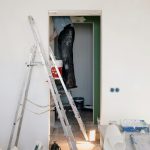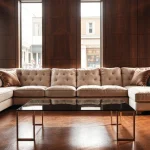Edwardian ceiling roses blend ornate Victorian detail with emerging modern simplicity, adding timeless charm to any room. Their varied designs—from intricate florals to clean spun plaster—reflect early 20th-century elegance while fitting diverse interiors. Understanding these decorative mouldings offers practical restoration tips and inspires fresh design choices, making them ideal for both period homes and contemporary spaces seeking classic character.
Understanding Edwardian Ceiling Roses: Historical Significance and Design Features
The rich aesthetic heritage of Edwardian architecture significantly influences ceiling detailing, especially in the form of ceiling mouldings and ceiling roses. The era, spanning from 1901 to 1910 under Edward VII, marks a transition from the ornate Victorian exuberance to a more restrained, elegant approach to interior embellishments.
Topic to read : Streamline your month-end close with these proven best practices
The Ceiling Roses Edwardian Style embody this shift by showcasing cleaner lines, nuanced motifs, and a focus on craftsmanship. These ceiling ornaments typically feature floral patterns, acanthus leaves, or simple geometric designs that complement the period’s refined taste. Their series of designs ranges from intricate and highly decorative to subtle, more modern versions—allowing for versatile application in both authentic restorations and contemporary adaptations.
Authentic Edwardian ceiling roses are distinguished by their use of materials such as cast plaster, offering durability while maintaining an authentic appearance. They often vary in size, from smaller centres suitable for modest rooms, to larger, more ornate medallions fit for grand hallways and parlours. Typical motifs include floral rosettes, sunflowers, and classical acanthus leaves, reflecting Edwardian tastes that preferred elegance without excessive ornamentation. Their sizes generally span from about 34mm to 77mm in diameter, aligning with the scale of room proportions typical of the period.
Have you seen this : Transform your e-commerce strategy with magento fulfilment
For those interested in restoring or enhancing heritage interiors, Ceiling Roses Edwardian Style serve as essential elements that revive the authenticity of the period. These designs not only complement Edwardian architectural features, such as high ceilings and decorative cornicing but also serve as focal points for lighting fixtures, accentuating the aesthetics of vintage or period-style homes.
Types and Styles of Edwardian Ceiling Roses
Ornate and Traditional Edwardian Ceiling Roses
The hallmark of Edwardian ceiling rose designs is a celebration of decorative plasterwork and period home features. Ornate examples, such as the LPR,72 and LPR,26, showcase floral motifs and acanthus leaves—iconic elements of Edwardian architectural details. These ceiling roses embody decorative ceiling centerpieces of their era, often serving as focal points in formal rooms. For those restoring Edwardian homes or wishing to replicate historic home restoration details, these vintage ceiling medallions provide authenticity and reinforce original period features.
Common diameters range from 34mm to 77mm, accommodating various ceiling proportions. Each piece was traditionally crafted using period-appropriate plaster ceiling roses installation techniques, ensuring their role in preserving historical interiors. The crisp casting of ornate ceiling decorations integrates perfectly with other classic home ceilings and molding styles present in Edwardian house embellishments.
Simple and Contemporary Edwardian Ceiling Roses
Not every Edwardian interior called for opulence. Designers also responded to the shift toward modernism by offering simple, elegant ceiling rose designs as part of their decorative ceiling centerpiece options. Models like LPR,74 and MPR,73 exhibit pared-back ceiling rose patterns, with clean lines and minimal ornamentation, making them suitable for both decorating period homes and updating rooms in a period-accurate manner.
These plain spun plaster ceiling roses work well for modest spaces or contemporary settings that nod to Edwardian period aesthetics without overwhelming the decor. Their presence supports the ongoing trend of incorporating historic plaster ceiling elements into an array of classic ceiling decorations—ideal for those seeking understated tradition in their Edwardian-era home decor.
Room-Specific Ceiling Rose Applications
Decorative plasterwork in Edwardian homes was never a one-size-fits-all solution. Room size, shape, and function all influenced ceiling rose styles by region and application. Large, ornate vintage ceiling medallions often anchor grand living rooms and entrance halls, adding iconic Edwardian motifs and dramatic symmetry in ceiling design. In contrast, bedrooms or bathrooms might feature plainer, smaller ceiling roses such as the CR33 or its 6mm variant CR34, ensuring decorative ceiling centerpieces are in scale with the space.
Selecting between ornate or simple cast plaster ceiling ornaments depends on the specific needs of each room in period home ceiling treatments. Kitchens and bathrooms often benefit from easy-to-clean, robust ceiling molding styles, while living areas can display ornate decorative rosettes for maximum impact. For authentic ceiling moldings and restoration, matching the ceiling rose dimensions and designs to each room’s purpose helps preserve the character and value of Edwardian home architecture.
Materials, Sizes, and Design Motifs
Common Materials and Construction Techniques
Edwardian ceiling roses primarily utilize cast plaster, a material celebrated in traditional interior embellishments for its authentic period feel and reliable durability. In the Edwardian era, decorative plasterwork evolved—moving from heavily ornate Victorian influences toward more restrained yet refined detailing, yet the core methodology remained: high-quality plaster was poured into detailed molds to create crisp, authentic ceiling moldings. This ensured every Edwardian architectural detail possessed intricate relief and historical accuracy. The benefits of these techniques are clear—cast plaster ceiling roses lend historic home restoration projects structural longevity, consistent detail, and a seamless look that integrates flawlessly with other plaster ceiling medallions. Interior decorators continue to choose durable plaster for ornate ceiling decorations because of its ability to preserve the integrity of original period features during restoration or reproduction.
Size Variations and Placement Guidelines
Ceiling rose sizes and dimensions in Edwardian homes range widely, accommodating everything from compact rooms to grand stairwells. Common diameters start as small as 34mm and reach up to 77mm, making them suitable for both modest vintage ceiling medallions and statement ornate plaster medallions in larger living areas. When selecting a ceiling rose, it’s vital to respect the proportions of the original Edwardian architectural detail—aiming for balance between the classic home ceilings and the decorative ceiling centerpiece. For example, a smaller decorative ceiling centerpiece suits cozy Edwardian bedrooms, whereas expansive sitting rooms invite use of larger, more intricate ceiling rose designs. Accurate measurement involves considering ceiling height, light fixture size, and the relationship to adjoining ceiling molding styles, helping achieve symmetry in ceiling design and ensuring each installation visually anchors the space. Precision in placement is fundamental for period-accurate ceiling details, especially in historic home restoration.
Popular Design Motifs and Aesthetic Trends
Moving from the elaborate flourishes of the Victorian period, the Edwardian era favored cleaner, lighter patterns—yet still cherished traditional decorative plasterwork. Floral ceiling rose designs—often sunflowers, acanthus leaves, or rose garlands—remain among the most popular, providing a subtle nod to nature and elegant heritage. Ornate plaster ceiling features might showcase geometric borders or stylized classical shapes, mixing restraint and detail to align with the Edwardian period aesthetics. Notably, the trend was toward simplicity and order: plainer ceiling rose patterns, such as gently spun medallions, became ideal for conveying understated grace. This trend supports both restoration of historic plaster ceiling elements and adaptation for contemporary classic ceiling decorations in modern homes. With options for custom ceiling rose designs and reproduction ceiling medallions, today’s plaster ceiling roses offer versatility—making them a preferred choice for decorating period homes while preserving a sense of timeless ceiling embellishments.
Restoration, Installation, and Preservation of Edwardian Ceiling Roses
Restoring Antique and Original Edwardian Ceiling Roses
Restoration of Edwardian ceiling roses prioritizes preserving historical interiors by maintaining authentic features. Use precision in repairing cracked or damaged decorative plasterwork; carefully clean original plaster ceiling roses to avoid further deterioration. Restoration specialists employ gentle brushing and non-abrasive cloths for cleaning floral ceiling rose designs and intricate molded ceiling trims. Care must be taken to retain the defining Edwardian architectural details, such as iconic Edwardian motifs and classic ceiling decorations, ensuring all repairs respect original period features.
Challenges often arise due to the delicate nature of antique ceiling decorations and original plaster ceiling features. Overzealous cleaning or modern repair products may threaten authentic ceiling moldings. Restoration projects in period home ceiling treatments require sourcing matching ceiling rose patterns and using compatible materials for plaster ceiling rose restoration, protecting the heritage of historic home restoration work.
Installation Tips and Best Practices
Installing a plaster ceiling rose begins with planning for wiring and ceiling rose integration, especially if pairing with period lighting focal points or chandeliers. Always disconnect electric supply before working, and confirm that light fitting with ceiling medallions will not compromise vintage ceiling medallions or ornate plaster ceiling features. Cast plaster ceiling ornaments are heavy; ensure the appropriate adhesive and fixings are used to support decorative plasterwork without damaging underlying Edwardian-era home decor.
During ceiling rose installation:
- Handle cast plaster materials with care to avoid crumbling delicate ornate ceiling decorations.
- Ensure mitred edges of ornate plaster medallions align perfectly at ceiling rose placement guidelines.
- Fill mitre joints with compatible plaster for seamless ceiling ornamentation history.
- Consider the scale and styling; ceiling rose sizes and dimensions should match the classic home ceilings and enhance traditional interior embellishments.
DIY installations appeal to those restoring Edwardian homes, but professional fitting remains advisable for larger or elaborately patterned period ceiling rose collections to ensure both safety and authenticity in preserving original period features.
Maintenance and Conservation Advice
Consistent maintenance is essential to safeguard elegant ceiling decoration ideas and the longevity of ornate decorative rosettes. Cleaning routines for antique ceiling decorations and Edwardian ceiling rose craftsmanship should involve soft dusting, avoiding harsh chemicals that could erode decorative ceiling centerpiece relief work. Homeowners should not use abrasive pads or water on molded ceiling trims, as moisture can weaken plaster.
Long-term conservation in heritage home accessories means periodic inspection for hairline cracks, paint flaking, or signs of moisture near ceiling molding styles and cast plaster ceiling ornaments. Address issues promptly, using appropriate materials, to avoid the loss of authentic ceiling moldings and preserve the value of decorating period homes with timeless ceiling embellishments. This supports both the detail and character expected in Edwardian home architecture and ensures preserving historical interiors across generations.
Purchasing and Customizing Edwardian Ceiling Roses
Finding Authentic and Reproduction Ceiling Roses
When seeking period-accurate details for a home, custom ceiling rose designs stand out as both practical and visually impressive. Ceiling rose suppliers UK cater to a growing demand for authentic features by providing a wide array of reproduction ceiling medallions. These specialist suppliers often showcase options such as ornate ceiling decorations, classic ceiling decorations, and cast plaster ceiling ornaments—each shaped by traditional craftsmanship techniques and Edwardian architectural details.
Thanks to advances in plaster casting, reproduction ceiling medallions capture the essence of original period features without sacrificing modern reliability. Many of these ceiling molding styles integrate floral ceiling rose designs, iconic Edwardian motifs, and decorative ceiling centerpiece elements. For homeowners wishing to restore or update historic interiors, these options ensure continuity in Edwardian-era home decor while preserving the integrity of their period home features.
Custom Design and Bespoke Services
Bespoke options enable clients to perfectly tailor custom ceiling rose designs to their home’s individual needs. This may involve selecting precise ceiling rose sizes and dimensions or creating a unique decorative ceiling centerpiece to match original period features. Collaboration with skilled ceiling rose craftspeople can also result in personalized ornate plaster ceiling features that echo authentic ceiling moldings found in heritage properties.
Restoring Edwardian homes often means adapting reproduction ceiling medallions to complement existing elements such as period home ceiling treatments and molded ceiling trims. Suppliers frequently pair clients with plaster restoration services and design advisors, guiding them in choosing appropriate ceiling rose patterns that reflect both historic home restoration requirements and the homeowner’s stylistic direction. These services extend to the careful integration of new elements with historic plaster ceiling elements—ensuring each component aligns with established Edwardian architectural details.
Cost Considerations and Selection Tips
Several factors influence the pricing of both reproduction ceiling medallions and custom ceiling rose designs. Materials used for decorative plasterwork, as well as the complexity of the decorative ceiling centerpiece and the overall size, all affect costs. More elaborate ornate decorative rosettes and historic plaster ceiling elements often command higher prices due to the skilled labor involved in their creation and the requirement for traditional craftsmanship techniques.
Choosing the right design involves balancing budget, project scope, and the aesthetic desired. Opting for modest ceiling rose sizes and dimensions may suit smaller rooms, while larger period ceiling rose collections or more detailed vintage ceiling medallions can serve as strong focal points in grander spaces. Consulting with reputable ceiling rose suppliers UK is essential for guidance on ceiling ornamentation history, practicality, and maintenance. This approach supports both preserving historical interiors and enhancing the character of Edwardian home architecture through thoughtful, period-accurate choices.
Styling Tips: Incorporating Edwardian Ceiling Roses into Interior Design
Complementing Period Features and Interior Elements
Integrating Edwardian ceiling roses with original period features requires attention to both harmony and aesthetic enhancement. For those seeking authentic ceiling moldings, pairing decorative ceiling centerpieces with Edwardian coving and crown moldings is fundamental. Classic ceiling decorations, such as ornate ceiling decorations or decorative plasterwork, create visual continuity when selected alongside Edwardian-era home decor—especially in spaces with high ceilings or sash windows.
Balance is crucial when coordinating ceiling rose designs with lighting fixtures. Decorative ceiling centerpieces often work best as a visual anchor for period lighting accessories like brass chandeliers or vintage pendants. When selecting a light fitting with ceiling medallions, ensure the fixture’s proportion and style echo the details found in your period home decor. In homes featuring ceiling molding styles common to Edwardian house embellishments, symmetry and scale should always lead your selection of ceiling roses for chandeliers or pendant lights.
Creative Decorating Ideas for Edwardian Homes
Color choice dramatically influences how ornate plaster ceiling features accentuate historic home restoration projects. Bold decorators might opt for contrasting shades—using a crisp white ceiling rose against a colored ceiling adds drama, while soft pastel tones reinforce a traditional interior embellishments palette. Matching the tone of the decorative plasterwork to that of classic home ceilings yields a subtle, seamless look, emphasizing timeless ceiling embellishments.
Detailing the ceiling with additional molded ceiling trims or installing complementary Edwardian architectural details can further elevate period home features. In homes with panelled ceilings or restored plaster walls, using multiple vintage ceiling medallions or mixing plain spun plaster with floral ceiling rose designs provides both depth and interest. The deliberate selection of ceiling roses in harmony with ceiling rose patterns found throughout the property ensures your decorating period homes scheme remains consistent with Edwardian ceiling rose craftsmanship.
Modern Uses of Edwardian Ceiling Roses
Contemporary interiors benefit from the enduring allure of authentic ceiling moldings. Even modern homes can integrate traditional interior design tips by incorporating reproduction ceiling medallions as focal points. The blend of ornate decorative rosettes with sleek furniture bridges the gap between historical interior accents and current trends.
Using decorative ceiling centerpieces in new builds and renovations gives a nod to historic plaster ceiling elements, introducing Edwardian ceiling rose popularity to a fresh context. Installers seeking ceiling rose authenticity factors can choose modern materials or custom ceiling rose designs, ensuring that these classic ornaments become part of the home’s narrative without overpowering more streamlined elements. Period-accurate ceiling details, when thoughtfully selected and installed, elevate both the architectural integrity and the overall ambience of Edwardian and contemporary spaces alike.











